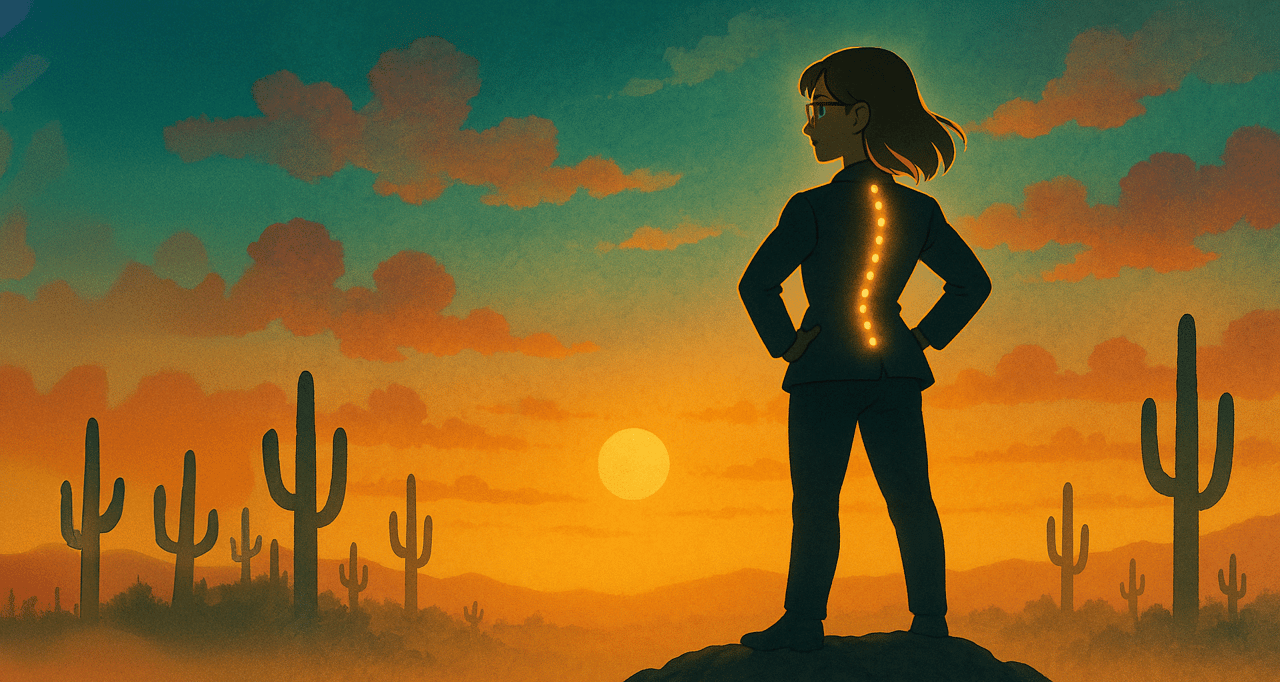
Strivenn Thinking
Pull up a seat at our
digital campfire
where story, strategy,
and AI spark
new possibilities
for sharper brands
and smarter teams.
What Does Scoliosis Have to Do with Branding?
By Jasmine Gruia-Gray
Everything, if you’ve ever worn something for years that made people see you a certain way.
In my teenage years, I wore a full-body brace to manage my scoliosis. I had a perfect S-curve in my spine, and the brace was supposed to prevent it from getting worse. I only took it off to sleep. It shaped how I looked, how I moved, how others perceived me and how I perceived myself. Without realising it, it became my brand.
Years later, just as I was finishing my microbiology undergrad, I underwent spinal surgery to correct the curves and fuse everything straight. Recovery was long. No high-impact activity, a lifelong commitment to core strength, and slowly earning back movement through pain, persistence, and a lot of strength and cardio.
The surgery gave me an inch in height and relief from back pain. What really changed was beyond my spine and muscles. Sure, there were physical changes (12-inch scar, mobility changes) as a result of the surgery, but more importantly, I felt like I could stand taller, metaphorically. I learned so much about how I wanted to show up in the world.
From |
To |
|
Focused on managing my pain |
Focused on the world around me |
|
Limited involvement |
Game to be involved with others |
|
Shy |
Engaging and supportive of those around me |
It was only later that I realised this shift from self-protection to connection wasn’t just personal growth. It was perceptual and changed how people experienced me. It was a brand transformation!
Brand isn’t what you say. It’s what others feel when they trust you.
A company’s brand isn’t just a logo, a tagline, or a colour palette. It’s the confidence customers feel when they choose you. That trust, the part that can’t be copied or coded by AI, meaning … the brand’s true essence.
The same applies to personal brand value, especially in commercial teams. Your name becomes shorthand for how you operate: how you follow through, what kind of energy you bring, and how you make others feel. By extension, this trust has a halo effect on the product/service and experience they are purchasing.
Your personal brand pulls people in, or pushes them away. It accelerates deals or makes them stall. It either earns trust, or drains it.
So how do you build a personal brand that actually adds velocity?
Here are three pillars that I’ve come to live by:
Pillar 1: Generous Expertise
- Practice: Offer bite-size insights that solve real problems, without strings attached. Be the person who simplifies the lab bottleneck or marketing headache without turning it into a pitch.
- It tells people: You’re here to help, not just to sell/promote.
- Watch out for: Gating every piece of content behind a form or “helpful” advice that quickly turns into a sales script.
Pillar 2: Empathetic Listening
- Practice: Start every conversation by asking one clarifying question and summarizing what you heard.
- It tells people: You get them.
- Watch out for: Listening just long enough to redirect to your solution or recapping in a way that feels like a setup for a pitch.
Pillar 3: Human Follow-Through
- Practice: Respond even when there’s nothing obvious to gain. Send an article that made you think of them. Say thank you. Be present in a way that makes others feel included.
- It tells people: You show up, no matter what stage the deal is in (or even if there is no deal).
- Watch out for: Ghosting after a stalled opportunity or cold LinkedIn messages with no context or connection.
For me, being present is about listening to understand, not to be heard. It’s about making a real connection through understanding their rationale, and their experiences. That awareness, the ability to connect with people on their terms is one of the most underrated assets a marketer or salesperson can have. It’s the thing AI still can’t do.
My scoliosis journey taught me about pain, posture, and persistence, and more than anything, it taught me about presence.
The physical straightening of my spine mirrored a deeper recalibration in how I wanted to live, lead, and contribute. It’s now part of my brand’s raison d’être: helping the next generation of commercial team players bring more clarity, intention, and empathy into their work.
Your personal brand is a long game
Every expert tip you share, promise you keep, and question you ask adds credibility that serves two travelers at once:
You – opening new doors, building referrals, and making your career more resilient.
Your company – turning your trust equity into pipeline velocity and customer loyalty.
It compounds.
So, if you want to start today:
- Define your brand essence: How do you want to be experienced? What do you want to be known for?
- Choose one action that reflects that identity.
- Make it a daily.
Need a prompt? Archie, the Strivenn Brand Archetyper might be able to help spark your thinking.
Alternatively, let’s have a conversation. I can be reached at jasmine@strivenn.com
Because posture isn’t just physical, it’s how you carry your brand in every interaction.



